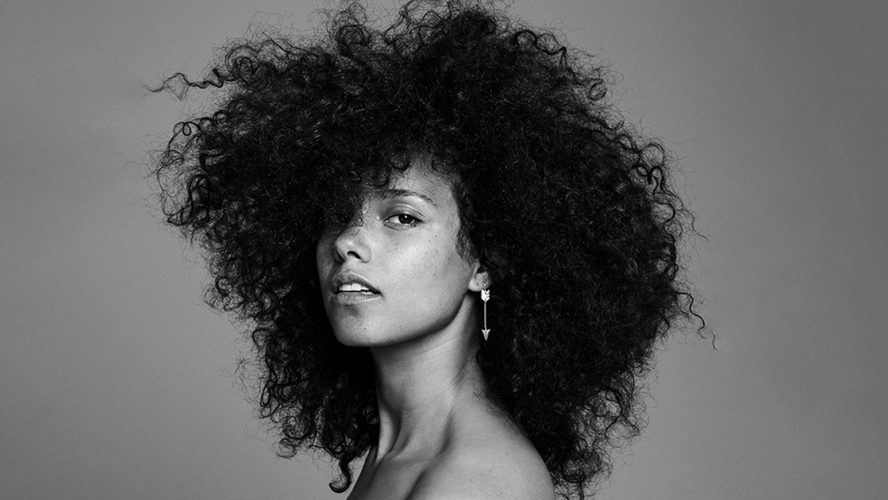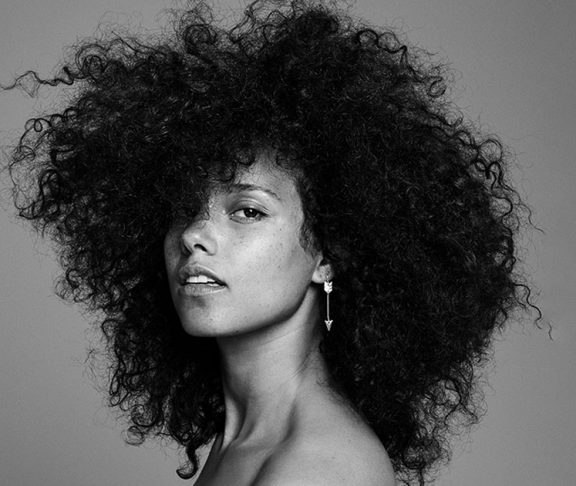The Grammy-winning vocalist takes us inside her work outside the studio, as well as inside her music to show how the two sometimes come together for a powerful cause.
A dedicated and influential advocate in the global fight against HIV/AIDS, Alicia Keys co-founded Keep a Child Alive (KCA) in 2003, to combat the impact of the epidemic on children and families in Africa and India. In September 2014, she also launched We Are Here, a movement empowering the global community to build a better world where all people are heard, respected, equal and treated with dignity.
What inspired you to get involved with HIV/AIDS advocacy work?
In 2001, I was asked to perform in a remake of Marvin Gaye’s “What’s Going On” that Bono and my dear friend Leigh Blake were producing. It was to draw attention to the AIDS crisis that was claiming millions of lives in Africa. Leigh had spent time there, and had seen first hand the despair of families and the needless deaths of so many people.
And why? Because they couldn’t get access to the lifesaving antiretroviral drugs available to us in the West. When Leigh explained to me how I could make a difference, and after I witnessed firsthand the suffering of children and families in South Africa, in 2002, I knew I would never be the same. I was totally onboard. I remember specifically feeling that whether you live or die should never depend on where you were born. We had to do something. I’d always had an affinity for children and I couldn’t forget the looks on their mother’s faces as they begged me for help getting the drugs, and so together we created Keep a Child Alive.
Do you see us reaching an AIDS-free generation on a national and global level?
When I hear the phrase “AIDS-free generation,” I think of the 36.9 million people still living with HIV today who, unless a cure is discovered, will never be free of the threat of AIDS. They’ll need medicine for the rest of their lives, including 2.6 million children.
The world is now on a mission to end AIDS by 2030. To do this we need to provide far greater access to treatment, because treatment is prevention, meaning that if a person with HIV is successfully on treatment it is very unlikely they will transmit the virus to others. So that means getting more people tested, enrolling them in care, and keeping them there. And that means addressing the issues that universally get in the way of testing and treatment and fuel this epidemic, such as poverty, stigma, gender inequality and violence towards children and women.
We all need to work together to have a shot at achieving this goal, but I especially want to call out the critical role of communities and community solutions: both here in the U.S. and abroad. In the history of AIDS, governments, pharmaceutical companies and other institutions have failed people living with HIV. What has kept the movement going? It’s empowered communities! It’s always been people living with HIV and community groups that have stood up and demanded accountability. That’s why at Keep a Child Alive we support grass-roots organizations in Africa and India that are rooted in their communities, treat people with respect and elevate the voices of children, youth, women and families infected with, and affected by, HIV.
And children and youth are being left behind. As a mother, it’s unacceptable to me that only 32 percent of children living with HIV who need treatment are getting it, and that AIDS is the number one killer of adolescents in Africa, and the number two cause of death worldwide. We have to do better. We can’t give up on this generation of kids.
But without the appropriate funding and resources, we won’t see an end to the AIDS epidemic. In September, the World Health Organization issued new guidelines stating that every HIV patient should be placed on antiretroviral drugs as soon as they test positive, rather than waiting for their immune system to begin failing. At last! But my question is: Where is the money going to come for this?
We need to keep AIDS in the headlines. We must keep pressuring our politicians to fund programs. We must speak out! As someone who’s witnessed the progress of the last 12 years, I’m determined not to let this opportunity pass us by. We now know what works. The tools and drugs are there. It ultimately comes down to whether we have the resolve and determination to see it through to the end.
On the song “We Are Here” you sing from the perspective of an expectant mother. Can you tell us about the inspiration behind this?
The song began with a simple question amongst friends. We were hanging out, and one of my friends asked me, “Why are you here?”—in the sense of what’s my purpose in life? That’s a big question, one that I invite everyone to ask of themselves. I was expecting [my son] Genesis at the time, preparing to bring another life into this world, against a backdrop of so much violence and pain—Israel, Gaza, Ferguson, Nigeria, Afghanistan. As a songwriter and musician, it’s my job to express issues through my music, so I started writing and found the answer in a song.
But it’s not just about my voice, it’s about raising our collective voice to get something done! So many people, especially young people, crave an outlet for their voice, on a myriad of different but interrelated issues. In my work with KCA and HIV, I learned that issues don’t exist in isolation. For example, you can’t seriously tackle AIDS unless you address homophobia, or women’s empowerment. It always bothered me that organizations are not working together to fix the wider social ecology, to deliver justice and equality for all, so we started the We Are Here Movement.
What are a few key points and lessons you want listeners to take away after listening to this song?
Use your voice. Shine a light on what’s going on that you care about. You have the power to make change, whether it’s ending the AIDS epidemic or some other issue that touches your heart. If we all change one life, we will together change a community, a country and then the world. Too often there are forces that try to divide us along racial, ethnic, religious, socio-economic lines. No! We are one. We are all here, at this amazing point in time, connected like never before. Let’s do something positive with that.
If you could tell readers one thing about the HIV and AIDS epidemic, what would it be?
This is not over! Yes, more people are on treatment, and globally there are fewer new infections today, but we’re not there yet, not by a long shot. We cannot let complacency and apathy slow, or maybe even halt, our progress. HIV continues to be one of the biggest challenges to humanity, needlessly taking lives in Africa, in India, and here in New York.
I invite everyone to join us, add your voice, your support. There are so many ways you can get involved and make a difference, and there is no small act, as many small acts focused on a common goal will create huge positive change. This is our moment to shine. Join me, and lets force the world we want into being.

